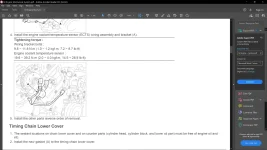carguy75
Registered Member
- Joined
- Jun 23, 2018
- Messages
- 3,067
- Reaction score
- 1,640
- Points
- 113
- Location
- Atlanta, Georgia
- Genesis Model Year
- 2015
- Genesis Model Type
- 2G Genesis Sedan (2015-2016)
True. I forgot about the one KIA model with the 5.0 engine. So three models total with the 5.0 V8 engine.I think the K900 has it too.
LOL. Here is what the service manual has for the coolant sensor which is 14ft/lbs-28 ft/lbs. This could be a problem as well that can cause some cracked front timing covers and a part shortage if these simple sensor changes are leading to replacement timing covers at dealerships service centers.
I will just install the oil and coolant sensors on my new cover only to the same amount of thread depth as the old ones on the cover.


























